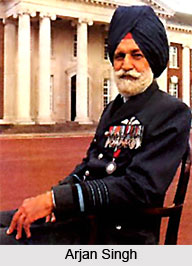 Arjan Singh is a man of all seasons and wonders, when one looks deep into the illustrious career of this Air Chief Marshal and later Marshal man. He has had a humble beginning from an Oakistan village, with disciplined education from British teachers. Later, with Singh`s sheer determination and grit, he got himself selected in the prestigious Air Force school Cranwell in England, which has remained Arjan Singh`s ultimate fascination since childhood. Thus was initiated a remarkable career of an Indian in pre-independent India, in the British Indian Air Force, also known as Royal Air Force. During the ongoing violent Second World War, Singh and his other co-cadets` times in Cranwell was cut short due to dearth of pilots back in India. Hence, Arjan Singh was called back to Indian by the British Indian Sir Force, with their only station in Ambala.
Arjan Singh is a man of all seasons and wonders, when one looks deep into the illustrious career of this Air Chief Marshal and later Marshal man. He has had a humble beginning from an Oakistan village, with disciplined education from British teachers. Later, with Singh`s sheer determination and grit, he got himself selected in the prestigious Air Force school Cranwell in England, which has remained Arjan Singh`s ultimate fascination since childhood. Thus was initiated a remarkable career of an Indian in pre-independent India, in the British Indian Air Force, also known as Royal Air Force. During the ongoing violent Second World War, Singh and his other co-cadets` times in Cranwell was cut short due to dearth of pilots back in India. Hence, Arjan Singh was called back to Indian by the British Indian Sir Force, with their only station in Ambala.
From Ambala, a flight of No. 1 Squadron went to Karachi and then to the North West Frontier Province (NWFP). This was close to the Durand Line; the terrain dictated the style of fighting much as it exercised in today`s clash in the said area. There were no big targets that could be hit. The Pathans hid in caves and valleys and took potshots at raiding aircrafts, intermittently managing to incapacitate some. Arjan Singh also had remained the target once.
The aircraft Singh flew while in British Indian Air Force were quite uncomplicated in design and technology. Arjan Singh and his men flew the Westland Wapiti and the Hawker Audax (a variant of the Hart for Army co-operation role).
To know the story from Arjan Singh of how he once had to emergency-land his warplane is to learn the process of initiation into the business of war. "At that time, the British idea was not to take over the area and have complete administrative control, but to give a live target and operational training to the soldiers. My experience is that unless you see the bullets coming towards you and some hitting you, you don`t have the experience of war. The first few times that you have these bullets hitting the aircraft, you are afraid. I was afraid. "
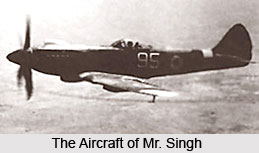 In 1940, Arjan Singh`s Hawker Audax was shot down in the NWFP by the Pathans. He had crashed in a parched hilly stream, where a fight was ongoing between the British/Indian troops, on the one side and the Pathans on the other. Singh`s gunner, Gulam Ali, was injured in the crash. As a result, Singh stayed back with him till they both could be evacuated. The incident is generally dismissed heedlessly by Arjan Singh. Within two weeks of the horrified incident, Singh was flying again, in the same area. Their fighting experiences in the NWFP, had prepared them for the fight, later on, against the Japanese. Arjan Singh`s times in the British Indian Air Force had by now gained considerable momentum, with both Singh`s useful experiences and talent at handling war time shortages. Singh maintains that operations over the mountains and valleys of the NWFP prepared him to face the tougher war against the Japanese during 1944 on the eastern front. He is of the view that one always is much afraid in the initial periods, but after a few operational sorties, it turns out to be a routine affair and the fear almost melts away. Singh, in his efficient career in British Indian Air Force had flown a total of 128 hours in operations over the Frontier Province.
In 1940, Arjan Singh`s Hawker Audax was shot down in the NWFP by the Pathans. He had crashed in a parched hilly stream, where a fight was ongoing between the British/Indian troops, on the one side and the Pathans on the other. Singh`s gunner, Gulam Ali, was injured in the crash. As a result, Singh stayed back with him till they both could be evacuated. The incident is generally dismissed heedlessly by Arjan Singh. Within two weeks of the horrified incident, Singh was flying again, in the same area. Their fighting experiences in the NWFP, had prepared them for the fight, later on, against the Japanese. Arjan Singh`s times in the British Indian Air Force had by now gained considerable momentum, with both Singh`s useful experiences and talent at handling war time shortages. Singh maintains that operations over the mountains and valleys of the NWFP prepared him to face the tougher war against the Japanese during 1944 on the eastern front. He is of the view that one always is much afraid in the initial periods, but after a few operational sorties, it turns out to be a routine affair and the fear almost melts away. Singh, in his efficient career in British Indian Air Force had flown a total of 128 hours in operations over the Frontier Province.
Arjan Singh had a long tenure in No. 1 Squadron with the British Indian Air Force. He had joined in 1940 and excluding a few months, he had been in the squadron all the time. He served as Adjutant and then Flight Commander. This was rather abnormal, since officers are generally repositioned after promotions.
The British Indian Air Force was equipped with the renowned Hawker Hurricane of the `Battle of Britain` fame in 1942 and most of its squadrons were given the aircraft during that year. This all-metal aircraft was sturdy and reliable. As Arjan Singh remembers: "I operated this aircraft on the North West Frontier Province (and later) against the Japanese and it never let me down even once." Squadron Leader Arjan Singh was made CO in September, 1943 in Kohat, presently in Pakistan.
It was as a Squadron Leader in British Indian Air Force that Arjan Singh first met Teji, the lady who went on to become his wife. He had flown from Kohat to Delhi to attend a Squadron Commanders` Conference on November 22, 1943, in which his old class fellow, Squadron Leader Prithipal Singh and the legendary Squadron Leader Mehar Singh and Squadron Leader K. K. (Jumbo) Majumdar were also participating. (Regrettably, Prithipal Singh and Majumdar expired in 1945 in Hurricane crashes and Mehar Singh passed away in a civilian aircraft crash after retiring from the IAF).
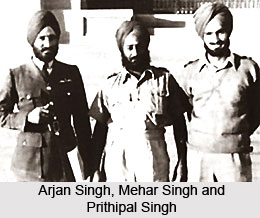
However, Arjan Singh`s lovey-dovey and tender times with his future beloved Teji never did take a central and overriding position in his flying domains with British Indian Air Force.
The bike or the car was far from his mind when Squadron Leader Arjan Singh went to Imphal in 1943 as Squadron Commander. War clouds were brooding over the darkened horizon. The situation there was wobbly since the Japanese strategy in Second World War was to enter India through the east. They had already conquered South-East Asia, including Burma and had laid a siege to the Imphal Valley. The only land route, Dimapur, Kohima, Imphal, had been chipped off by the Japanese. All the forces in the valley were supplied by transport aircraft, mostly by the American Air Force, diverted from the other task of supplying the forces of Chiang Kai-Shek "over the Hump" of the 18,000 to 22,000 ft. above sea level high mountain ranges between Assam and China.
The squadron captained by Arjan Singh in British Indian Air Force was stationed in the valley. It played a significant role in helping the Indian/British Army fighting in the valley to hold back the siege and overwhelm the Japanese forces. They attacked Japanese troops and supply lines, though there was not much aerial combat. There was a healthy rivalry between the RAF and the IAF and this gave the IAF (Indian Air Force) a chance to prove that they were as good as the RAF, if not better, at fighting against well-established enemies. This they accomplished by flying long and dangerous hours and relentlessly hitting the enemy troops.
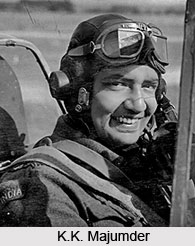
Arjan Singh`s heroic and eventful life with the British Indian Air Force is eulogised by another prestigious rank holder in Indian Air Force, Air Chief P. C. Lai. In his book, My Years with the IAF, published in 1986, Lai says: "The first person to actually see the Japanese in the northern part of Imphal was Squadron Leader Ajran Singh. He had been on a sortie, attacking the Japanese elsewhere and he was coming back to base in the afternoon flying his aircraft solo at that time. Coming back to circuit and land at his base, he saw on a hilltop overlooking the airfield a number of men in a strange uniform that did not resemble any uniform or any men of the Indian Army. So he went close to have a look and recognised them as Japanese troops. He immediately called his entire squadron on his own initiative. The other aircraft that were on the ground were also made ready to go. He was the first to attack the Japanese, who had actually arrived on the outskirts of Imphal." Documents published later have demonstrated that this attack by the whole squadron, i.e. 16 aircrafts were the turning point and final reversal of their ambitious plan to capture the valley.
The above-mentioned worthy quote by an officer on another flying officer hugely reflects that Arjan Singh`s leadership had a distinctive style - quiet courage, with complete absence of flamboyance and decisiveness with a ready smile. He and his men were the heroes of Imphal. Truly, Singh had performed a great job.
The leadership of Squadron Leader Arjan Singh under British Indian Air Force was noticed and he was given the immediate award of the Distinguished Flying Cross (DFC) in May, 1944, by Lord Louis Mountbatten, Supreme Allied Commander of South-East Asia during Second World War. The feat was commemorated with a small ceremony at the airfield itself. Lord Mountbatten addressed the squadron while standing on the wing of Squadron Leader Arjan Singh`s Hurricane and pinned the DFC on his chest. "I was dressed in my jungle fatigues," remembers the Marshal. The decision to award Singh DFC however was not an entirely a surprising moment. Lord Louis Mountbatten had given the squadron approximately two hours notice; the air force men gathered, with some officers and airmen of the squadron, but they did not stop the operations even then. For a young man like Singh was then, to receive such a medal in front of his own squadron was a matter of great satisfaction.
Pilots almost always depended on the ground technical staff to keep the planes in sound and healthy condition. Arjan Singh fondly recollects his days in British Indian Air Force and the contribution of the technical hotshot who looked after the planes-Group Captain Ram Singh, MBE (Member of the British Empire). He belonged to Sansarpur village, near Jalandhar in Punjab, which is celebrated for producing legendary hockey players. Ram Singh was the first person to join as Hawai Sepoy.
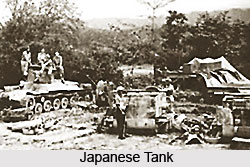
In all, Arjan Singh`s squadron got nine DFCs - which is quite a record. No other squadron, whether Indian or British, got so many DFCs on the Burma Front. But the cost was woefully high - out of the 21 pilots who originally went from Kohat to Imphal, only five returned. Two of the DFC-winners, Air Vice-Marshal A. R. (Nifty) Pandit and Group Captain (Nanu) Shitoley were among the first to congratulate the Marshal of the Indian Air Force when his new rank was announced. Following such a long stint on the front, the squadron was moved and its chief given a peace-time posting. Arjan Singh`s times - both perilous and peaceful, with British Indian Air Force, shall always be recollected with boldness and daring, when Indian Air Force would fly to even unknown territories for their country.




















